Modern Random Chess
Esta es la version en ingles de la pagina del Ajedrez Aleatorio Moderno.
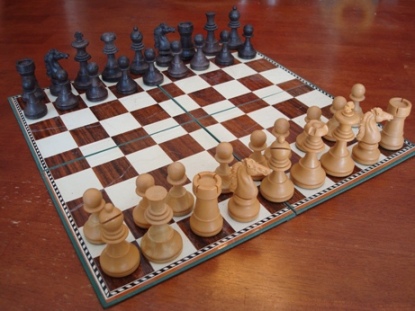
MRC Position #6,494 - BMRNBQKNR
Modern Random Chess (MRC) is a blend of concepts from Gabriel Vicente Maura's 1968 Modern Chess (9x9 setup, Reverse Symmetry, symmetric castling to either side, an extra pawn, the Prime Minister (B+N) and a Bishop Adjustment Rule) with some random concepts & the castling formula from Fischer Random Chess (FRC).
Setup
 ....
....
 ....
....

MRC Positions #6,787 (left), #4,212 (middle) and #1,025 (right)
All pieces are randomly placed in the player's first rank, with the only restriction that the King must be between the two rooks. It is possible for both Bishops to be on the same color squares (dark or light squares). The opponents' pieces are placed with reverse symmetry (White's piece at a1 is equivalent to Black's i9, White's b1 to Black's h9, White's c1 to Black's g9, White's d1 to Black's f9, and so on)
There is a Bishop Adjustment rule that is in effect only in games when both Bishops start on the same color squares in the initial random setup. This rule allows players to move one of the Bishops to the opposite color, if they so desire.
There are 15,120 different legal starting positions in Modern Random Chess, one of which is Maura's Modern Chess initial layout.
If Maura's original Modern Chess position (MRC position #6,944) was randomly selected, it can be played with the rules for Modern Random Chess, just like the original game.
Reverse Symmetry
In a reverse symmetrical setup the piece at the square a1 for White, is the same as the piece at i9 for Black. The piece at b1 for White is the same as the one at h9 for Black, and so on. The Pawns are in the second row of each player's side.
Let looks at another example, from both White and Black's point of view: (MRC Position #2,300)
 ....
....

In the MRC position on the left, from White's point of view, the Bishops are both on his leftmost dark squares, his Queen is to the right of the King, his Prime Minister is on his right corner, and so on. Also, from White's point of view, his opponent's Minister is on the opposite corner across the diagonal as his own, the opponents Queen is across the board from the Rook to the left of his King, and you could continue to describe the position of the opponent's pieces in relation of White's own.
Now look at the same MRC position in the diagram on the right, but from Black's point of view. Every single observation made from White's point of view above, applies as well to the point of view from Black. That's reverse symmetry!
Pieces
Orthodox Chess pieces are used, plus a Prime Minister (Bishop+Knight) and a 9th Pawn per side.
Approximate Value of the Pieces on a 9x9 board
- Queen - 11 points
- Minister - 10 points
- Rook - 7 points
- Bishop - 4 points
- Knight - 4 points
- Pawn - 1 points
Practical Value of the Pieces (adjusted to an 8x8 board)
- Queen - 9 points
- Minister - 8 points
- Rook - 5 points
- Bishop - 3 points
- Knight - 3 points
- Pawn - 1 points
Gabriel Vicente Maura's Prime Minister (from his book Mathematical Thesis of Modern Chess):
Kings and their Prime Ministers
Homemade Prime Ministers
Knight crowned by small Bishop, Bishop crowned with small Knight, and a crownless King.
Knights crowned with the heads of Bishops.
The Prime Minister is the only piece that is able to give a checkmate on it's own. Sample Prime Minister's checkmates:
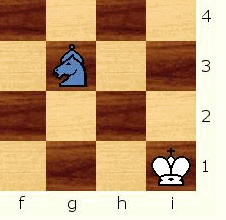

Rules
Most Orthodox Chess rules apply, including the objective of the game, the way pieces move and capture, en passant, check, checkmate, and the various draw situations (i.e. stalemate, insufficient mating material, threefold repetition, 50-move rule). Pawns may promote to a Queen, Minister, Rook, Bishop or Knight. Modified Castling rules are below, as well as the new Bishop Adjustment Rule.Castling
The MRC castling
rules are based in the Fischer Random Chess rules.
In Modern Random Chess, depending on the pre-castling position on the castling King and Rook, the castling manoeuvre is performed by one of these four methods:
- Double-move castling: By on one turn making a move with the king and a move with the rook.
- Transposition castling: By transposing the position of the king and the rook.
- King-move-only castling: By making only a move with the king.
- Rook-move-only castling: By making only a move with the rook.
After castling, the rook and king's final positions are exactly the same positions as they would be in Maura's Modern Chess. Thus, after c-castling (notated as O-O-Oc), the King is on the c-square (c1 for White and c9 for Black) and the Rook is on the d-square (d1 for White and d9 for Black). After g-castling (notated as O-O-Og), the King is on the g-square (g1 for White and g9 for Black) and the Rook is on the f-square (f1 for White and f9 for Black).
This table shows where the King and Rook end up and the notation for each type of castling.
| White castles a-side | c-castling | O-O-Oc | Kc1, Rd1 |
|---|---|---|---|
| White castles i-side | g-castling | O-O-Og | Kg1, Rf1 |
| Black castles a-side | c-castling | O-O-Oc | Kc9, Rd9 |
| Black castles i-side | g-castling | O-O-Og | Kg9, Rf9 |
However, castling may only occur under the following conditions, which are extensions of the standard rules for castling:
- Unmoved: The King and the castling Rook must not have moved before in the game, including a previous castling or a Bishop Adjustment.
- Un-attacked: All of the squares between the king's initial and final squares (including the initial and final squares) must not be under attack by any opposing piece.
- Vacant: All the squares between the king's initial and final squares (including the final square), and all of the squares between the rook's initial and final squares (including the final square), must be vacant except for the king and castling rook.
- Castling cannot capture any pieces.
- The king and castling rook cannot "jump" over any pieces other than each other.
- A player may castle at most once in a game.
- If a player moves his king or both of his initial rooks without castling, he may not castle during the rest of the game.
- In some starting positions, some squares can stay filled during castling that would have to be vacant in Modern Chess. For example, after c-castling (O-O-Oc), it's possible for to have a, b, and/or e still filled, and after g-castling (O-O-Og), it's possible to have e, h and/or i filled.
- In some starting positions, the king or rook (but not both) do not move during castling.
- In some starting positions, castling can take place as early as the first move.
- The king may not be in check before or after castling.
- The King cannot move through check.
- The King cannot jump over his own rook if and when said rook stands on a "checked" square.
- A King that has swapped places with a Bishop according to the Bishop Adjustment rule can no longer do castling for the rest of the game.
- A Rook that has swapped places with a Bishop according to the Bishop Adjustment rule can no longer castle with the King.
- Castling in MRC is symmetric to either side of the board. MRC Castling is like the Orthodox long castling (O-O-O) but to either side.
The Bishop Adjustment Rule
In those positions where the Bishops start up in the same color squares (either both on dark or light squares), players on their turn, are allowed to convert one (and only one) of their Bishops to the opposite color square by swapping places with any piece adjacent to them. Neither the Bishop nor the piece to be adjusted with may have moved before the Bishop swap. The Bishop adjustment will count as a single turn, and a move for both the Bishop and the piece swapped with.The Bishop Adjustment Rule is optional, and a player is not forced to use it. A player may choose to play with his Bishops on the same color squares if he so desires, even if his opponent chooses to adjust one of his Bishops. The Notation for the Bishop Adjustment is 'Bx <=> piece adjusting with', where x is the rank (column) the Bishop is at before the adjustment (i.e. Bc<=>Q stands for a Bishop on the c file adjusting with the Queen).
Note that the Bishop Adjustment rule has the following consequences in MRC:
- In addition to allowing the Bishop swap places with a Knight, the Queen or the Minister (like in Maura's Modern Chess), it also allows the Bishop to adjust with a Rook, or the King!
- If the Bishop Adjusts with a Rook, that rook will be considered to have moved, and King Castling with that rook will no longer be possible. King Castling with the other Rook will still be possible provided neither the second Rook nor the King have moved.
- If the Bishop Adjusts with the King, the King will be considered to have moved, and King Castling will no longer be available for the rest of the game.
- If the King is in check, it is not legal to move out of check with a Bishop Adjustment.
- A King may not move into check after a Bishop Adjustment.
- A Bishop on a corner may only adjust with the one piece adjacent to it.
Sample Bishop Adjustments
Jose Carrillo - Luis MenendezMRC position #2,264
May 2008
 ...
...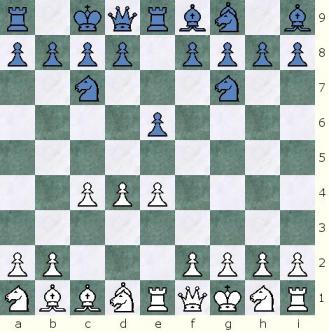
Position after 3... e6; and after 4.Ba<=>N Bg<=>M (both White and Black Adjust their Bishops on the 4th move)
Modern Random Position IDs
There are 15,120 different starting positions in Modern Random Chess.To calculate the total number of positions we follow this process:
First, lets place the Bishops. There are 9 empty squares, and since Bishops are allowed on same color squares, there are 9 posible squares to place the first Bishop and 8 squares to place the second Bishop.
9 x 8 = 72 different ways of placing the Bishops
Since there is no way to differentiate the Bishops, and they are actually interchangeable, there is actually 36 of these 72 positions that are actually visually unique.
After placing the Bishops, there are 7 squares left, 7 diferent squares to place the Queen and 6 different squares to place the Prime Minister.
Now there are:
36 x 7 x 6 = 1,512 visually uniquely different ways to place the Bishops, the Queen and the Prime Minister.
There are 5 squares left to place the Knight King and Rooks, and 10 defferent combinations to do it, according to KeRN codes (legal Fischer combinations of Knights, Rooks and the King; which also apply to Modern Random Chess). See the KeRN codes table below:
KeRN Codes:
0 N N R K R (Knight, Knight, Rook, King, Rook)
1 N R N K R (Knight, Rook, Knight, King, Rook)
2 N R K N R (and so on...)
3 N R K R N
4 R N N K R
5 R N K N R
6 R N K R N
7 R K N N R
8 R K N R N
9 R K R N N
Therefore there are:
1,512 x 10 = 15,120 different Modern Random Chess initial positions
Notes
Modern Random Chess has been played on Chess Variants' Game Courier by players from the following countries: Puerto Rico, Canada, Mexico, Austria, Peru.
Sample Games
The First MRC game ever!
MRC Position #6,787 - BQRMBNKNRLuis Menendez (PUR) - Jose Carrillo (CAN)
CV Game Courier, April 2008

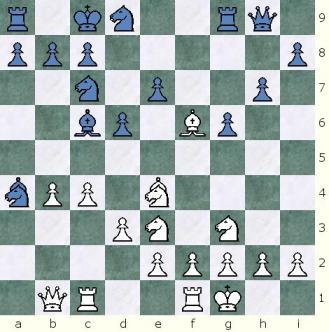
1.c4 h7 2.Ne3 g6 3.Ng3 Be <=>M 4.d3 Nbc7 5.Bc3 d6 6.b4 Bxc3 7.Mxc3 Md7 8.Me4 e7 9.a4 Mxa4 10.O-O-Og f6 11.Bxf6! Bc6 (diagram on the right)
White had set up a trap! but Black didn't fall for it. After 11...exf6?? 12.Mxf6+! threatened checkmate in 2 moves with the Minister at d8.

12.Mxd6? exf6 13.Nd5 Bxd5 14.cxd5 Qxd5? 15.Mxg9 Qg8 16.Md6 Mb6 17.Me4 Md7 18.Qb2 Qf8 19.Qa3 Qi5! (diagram above)
Now it's Black who sets up a trap and a checkmate threat at i2. After 20... Qxi2+ 21.Nxi2 Mxi2#, mate with the Minister.

20.f4 Mg4 21.d4 Ne7 22.Rxc7 Qh4! 23.Rxc8+ Nxc8 24.Mf3 Mxf3 25.Rxf3 f5 26.b5 Qe7 27.Qb3 O-O-Oc 28.Rc3 Kb9 29.d5 Nb6 30.Rd3 Qd6 31.e3 Qc5 32.d6 Qc4 33.Qb1 Qe6 34.Ne2 Rxd6 35.Nd4 Qe4 36.h3 Nc4 37.Qc2 Nxe3 0-1 (diagram of final position above)
Black has threats all over the place!
MRC Position #11,017 - MQBRNBNKR
Carlos Cetina (MEX) - Jose Carrillo (CAN)
CV Game Courier, May 2008


1.e4 f6 2.d4 e6 3.f4 d6 4.Ngf3 Bh5 5.d5 e5 6.h3 Mh7 7.c4 Ngd7 8. b4 g6 9.g4 Bi6 10.Be3 Mi5 11.Kh2 h6 12.Rg1 f5 13.gxf5 exf4 14.Bxf4 g5 still in progress
MRC Position #12,731 - RKBNNQBMR
Jose Carrillo (CAN) - Carlos Cetina (MEX)
CV Game Courier, June 2008


1.e4 f6 2.d4 e6 3.Bc
<=>N a6 4.f4 a5 5.g4 a4 6.a3 d6 7.Ned3 d5 8.e5 Nd7 9.Ne2 Ne7 10.Ng3 c6 11.Bf3 f5 12.gxf5 Nxf5 13.Nxf5 exf5 14.Mg3 Nb6 15.Qh3? Nc4 16.Qg2 Qb7 17.Ka2 Me6 18.Rb1 Bce7 19.Nc5 Bxc5 20.dxc5 Bxc5 21.Bxc5 Mxc5 22.Mxf5?? Ne3! 23.Qg1 Qb3+!! 24.cxb3 Mxb3# 0-1 mate!
Armin Liebhart (AUT) - Jose Carrillo (CAN)
CV Game Courier, July 2008


1.e4 d6 2.Ng3 Bf <=>M 3.Nh3 i7 4.Bd <=>M Bi8 5.Nf4 Nb7 6.Mi6? Bh7 7.Mg5 Bd8 8.Mf3 c6 9.d3 Nc7 10.h4 e6 11.i4 e5 12.Nh3 Me7 13.Ng5 Mg6 14.Bd2 f6 15. h5 Mi5 16. Nxh7+ Mxh7 17. Nf5 Qe8 18. g4 O-O-Oc 19. a3 g6 20. hxg6 Mxg6 21. Ri1 Rg9 22. Ba2 Mi5 23. Mh2 Rxg4 24. f3 Rg6 25. O-O-Oc Rdg9 26. Mi3 Nd9 27. Bb4 c5 28. Nxd6 Nxd6 29. Bxc5 Be7 30. Qh1 Rh6 31. Qxh6?! Mxh6+ 32. Kb1 Mf4 33. Bxd6 Bxd6 34. Mxf6+ Qd8 35. Mh7 Rg7 36. Mf5 Qb6 37.Bb3 Nf8 38. Rh1 Ng6 39. Rdg1? Md2+ 40. Ka2 Ra7! 41. Rxg6?? Rxa3+!! 1-0 (after 42. bxa3 [forced] 21.Mc3#)
MRC Position #6,944 - RNBMKQBNR (Maura's Modern Chess starting position)
Jose Carrillo (CAN) - Luis Menendez (PUR)
CV Game Courier, March 2008
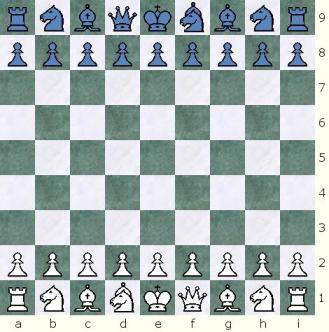

1.e4 d6 2.f4 e6 3.Bg
<=>Q Nc7 4.Nc3 Bc
<=>Q 5.d4 Ng7 6.Ng3 h7 7.Bc4 Bf7 8.Me3 Bh8 9.Qf2 Me7 10.O-O-Og O-O-Og 11.f5 exf5 12.Bxf7 gxf7 13.Nxf5 Mf6?! 14.Nxd6 Mh4!? 15.Nxf7+ Kh9 16.Qxh4!! Qxh4 17.Nxh8! Kxh8 18.Mi7+! Ki9 [forced] 19.Mg8+ Kh8 [forced] 20.Mf7+ 1-0 (after 20... Ki9 [forced] 21.Bi7!, White threatens 22.Mg8# and 22.Bh8#)
MRC Position #???? - NRBQNMKBR
Nicholas Wolff (USMC) - Jose Carrillo (CAN)
CV Game Courier, October 2009


1.e4 f6 2.d4 e6 3.Mg3 d6 4.Nb3 Nf7 5.Nd3 Bf8 6.Qi6 g7 7.Qxi8 Nh7 8.Qi3 Ri9 9.Qh3 c7 10.Be3 e5 11.Qh4 Me7 12.dxe5 fxe5 13.Qh5 Nf6? 14.Qxf7 Bc8 15.i3 Bd9 16.Qc4 Bg6 17.Bi2?! Nxe4 18.Me2 Qc6 19.Qxc6 Mxc6 20.f3 Nf6 21.a3 O-O-Oc 22.Bg5 Be7 23.Nb4 Ma7+ 24.Kf1 Ng8 25.Bxe7+ Nxe7 26.Rc1 Me3+ 27.Ke1 Nd5 28.Nxd5 Mxd5 29.c4 Me3 30.Bh3 Bi4 31.Rc3 Mg5 32.Bxi4 Rxi4 33.Mg3 Ri9 34.Ke2 Rde9 35.Mf5 Kd8 36.h4?? Mf4+ 37.Kf2 Mxi1 38.Mg6 Kc8 39.Mxh8 Rxi3 40.Mxg7 Mg3+ 41.Ke3 Mf4+ 42.Ke4 Rg9 43.Mf5+ Kd8 44.g4 Mg6 45.Mxg6 Rxg6 46.Na5 Kd7 47.b4?! Rf6!? [... Rxf4+!?] 48.c5?? Rf4+! 49.Kd5 Rd4# 0-1 mate!
Game Courier Preset
Modern Random Chess presetChess Variants by the Author:
- Modern Chess Complex
- Modern Random Chess (9x9)
- Contemporary Random Chess (8x8)
- Prime Ministers Chess (9x8)
- Pseudo-Modern Random Chess (9x9)
- Chess8400 (9x9)
- Prime Ministers Contemporary Random Chess (8x8)
- Prime Ministers Random Chess (9x8)
- Hia Chess (9x8)
- Modern Capablanca Random Chess (10x8)
- English Chess Complex
- Modern English Random Chess (10x10)
- International Contemporary Random Chess (10x10)
- International Fischer Random Chess (10x10)
- Courier Chess Complex
- Courier Chess Moderno (12x8)
- Mini Courier Chess Moderno (10x8)
- Silver Elephant Chess (10x8)
- Modern Ministers Courier Chess (11x8)
- Ajax Complex
- Ajax Chess (10x10)
- Ajax Orthodox Chess (8x8)
- Ajax Random Chess (8x8)
- Ajax Modern Random Chess (9x9)
- Ajax Ministers Chess (10x8)
- Ajax Falcon Chess (10x8)
- Ajax-Capablanca Chess (10x8)
- Korean Random Chess (9x10)
- Latrunculi XXI & Petteia XXI (10x8)
- Partnership Chaturanga (8x8)
Other Presets by the Author:
- Chaturanga - Davidson Variation
- Modern Chess Preset
- Fischer Random Chess Preset
- Makruk (Thai Chess) Preset
- Ajax Xiangqi (9x10) proposed by Charles Gilman
- Ajax Bigamous Chess (9x8) by Carlos Cetina
- Ajax Euchess (10x10) by Carlos Cetina
- Frolov Chess - Ajax Variation (9x9)
- Hiashatar (Mongolian Decimal Chess) (10x10)
- Milenium 3D Chess (8x8x3) by William L. D'Agostino
Other Pages by the Author:
- How to Generate Random Positions
- The Bishop Adjustment Rule
- The Modern Principles
- Reverse Symmetry
- The Prime Minister
- The Courier Elephant
- The 10x8 Variants
- Checkers Variants
Acknowledgements:
I dedicate this variant to my cousin Herminio Quiles Matias who taught me to play Orthodox Chess during a family visit to Jayuya, Puerto Rico, when I was 10 years old. God Bless You!Thanks to Luis Menendez, from Manati, Puerto Rico, for introducing me to Maura's Modern Chess, and for giving me the original Modern Chess set below as a present.

Thanks to Carlos Cetina, from Mexico, for giving me the clue needed to finish the definition of the new general Bishop Adjustment Rule.
Modern Random Chess was created by Jose Manuel Carrillo-Muniz, from Puerto Rico in March 2008.
List of items authored by: Jose Carrillo
 This 'user submitted' page is a collaboration between the posting user and the Chess Variant Pages. Registered contributors to the Chess Variant Pages have the ability to post their own works, subject to review and editing by the Chess Variant Pages Editorial Staff.
This 'user submitted' page is a collaboration between the posting user and the Chess Variant Pages. Registered contributors to the Chess Variant Pages have the ability to post their own works, subject to review and editing by the Chess Variant Pages Editorial Staff.
By Jose Carrillo.
Web page created: 2008-05-10. Web page last updated: 2008-06-01
